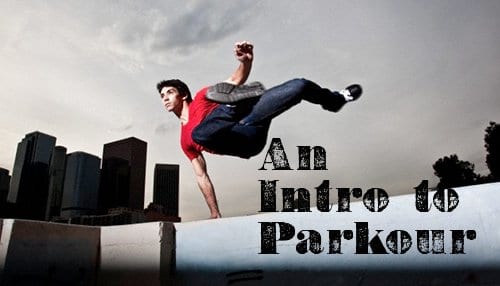
You’ve seen it on TV shows such as American Ninja Warrior (and not so seriously in The Office) as well as in movies like Casino Royale and The Bourne Ultimatum. If you’ve played Assassins Creed or Mirror’s Edge, you’ve even done it, virtually, at least.
I’m talking about parkour.
Yeah. That sport where you jump from buildings and vault over walls. Many men are drawn to parkour even if they’re not entirely sure what it is. It’s captivating to see someone move through an environment in ways we had previously not conceived of, and inspiring to witness the human body pushing the very limits of its capabilities. Plus, it just looks like so much fun and it seems like an important skill to have during the zombie apocalypse when you’ll need to be able outrun a pack of vicious brain-eaters (depending on your theory of their bipedal capabilities, of course).
To learn more about parkour I visited the Tempest Freerunning Academy in Los Angeles to talk to parkour/freerunning instructor, stuntman, Ninja Warrior veteran, and epic handlebar mustache owner Brian Orosco.
What is Parkour?
Parkour is all about moving through your environment efficiently and naturally. Parkour practioners, who are often called traceuers (from the French for ‘to trace’), jump, climb, and vault over obstacles in their path. Their goal is to get from point A to point B as efficiently as possible.
The history of parkour is actually pretty fascinating. It got its start in France and has its roots in military escape and evasion tactics and 19th century physical culture. In fact, the word “parkour” originates from the French phrase “parcours du combattant:” the obstacle course-based method of training used by the French military. So while we think of parkour today as simply an interesting form of recreation, it was actually developed as a tactical skill and way to build the fitness of soldiers.
The Difference Between Parkour and Freerunning

Parkour and freerunning get used interchangeably. While they share a lot in common, there is a small difference.
Parkour is simply about maneuvering through your environment efficiently using jumps, swings, and vaults. No need for flips, wall spins, and other acrobatics. With freerunning, efficiency is less of a concern, and you can throw in these types of cool-looking acrobatic movements as well.
So when you’re watching YouTube videos of people doing flips and spins off walls, that’s freerunning; if they’re just jumping and vaulting over urban obstacles without acrobatics, they’re doing parkour.
Why Practice Parkour?
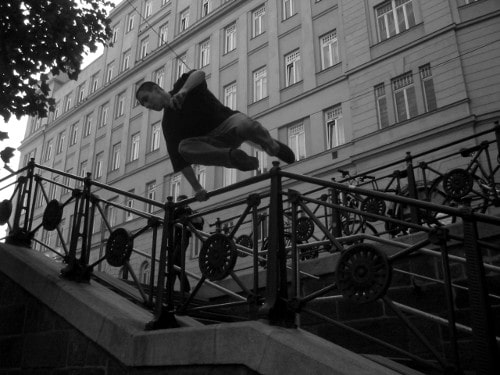
Parkour is fun! In parkour, you basically treat the world around you like a giant playground. It’s fun to find novel ways to maneuver through your environment, and, yes, pretend you’re running away from ninja assassins and/or zombies. It harnesses your inner child that has long been dormant and just wants to run around, explore without limits, and simply play again.
Parkour is great exercise. Running, jumping, climbing, swinging. Parkour is a full-body workout that will simultaneously improve your body awareness and coordination.
Parkour is a challenge. Parkour will require you to push yourself physically and mentally. Starting out, you may not be able to do certain moves, but with time, you’ll gain the strength and coordination you need to master them. You’ll face obstacles that you think you could never surmount, but when you dig deep within yourself, you’ll find that you can push your body beyond what you saw as its limit. In short, parkour can help activate the primal switch of manliness within all of us for a challenge. As you overcome these challenges you’ll gain confidence in yourself that will carry over into other parts of your life.

Source: Daily Texan
Parkour is a great way to make new friends. Parkour is a social sport. It’s typically done in groups, and the parkour community is very friendly and supportive. It’s not competitive; rather, the goal is to have a good time and to help each other improve.
Parkour can help save your life. We’re big proponents of the idea that every man should be able to save his own life should the circumstances arise. Parkour gives you the skills and physical conditioning to do that. We joke about zombies and having to escape and evade in an urban environment, but what if the day comes when your life depends on being able to run, jump, and climb over obstacles? Would you be able to do it? Parkour can help. It’s particularly handy when you have to jump from rooftop to rooftop.
Parkour makes you more creative. Parkour requires you to look at your environment creatively. Instead of interacting and maneuvering through the world as some architect or city designer wanted you to, you do it the way you want. Stairs? We don’t need no stinkin’ stairs! Oh, you want me to use this little pedestrian bridge? I’ll just jump over this gap and swing under this rail. Every fence, wall, or gap becomes an opportunity to try a new move. This sort of playfulness and creativity can seep over to other areas of your life, helping you find creative solutions to problems at work or in your relationships.
How to Get Started With Parkour
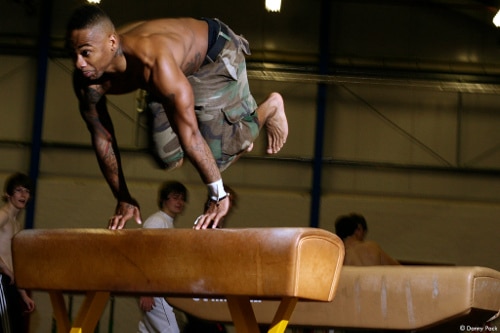
Find a parkour group. The best way to get started in parkour is to find a local group and attend a parkour jam. People in the sport’s community are super friendly and supportive of one another. You’ll get insights from folks who have been doing it for awhile, plus you’ll have someone there to spot you on particularly hard moves. And of course, if you take a bad fall, you’ll have someone who can take you to the hospital. Most big cities have parkour meet-ups; you can find them on Meetup.com and the American Parkour forums.
Another great way to get started is to join a parkour gym like the Tempest Freerunning Academy if you’re lucky enough to have one in your area. These types of gyms are pretty new, and there aren’t too many out there right now, but more will likely be cropping up in the next several years as the sport continues to grow in popularity.
Be safe. Don’t take unnecessary risks. Your goal is to have a good time and push yourself beyond your comfort zone, but without hurting yourself. Your first question before any movement should be, “How can I do this without injuring myself?” Make sure to train with a group or a partner so they can spot you on demanding moves and call for help if needed. Before any training session, check the environment for any potential hazards, like broken glass and the like. In short, don’t be stupid.
Take it slow. Know your limits. Just because those around you are doing crazy flips and aerials from giant buildings, doesn’t mean you have to. Don’t try to do too much too soon. It’s going to take awhile for your body to adapt to the physical demands of parkour. Don’t move on to more complicated moves until you’ve mastered the basics. On a related note, don’t get so cocky about your abilities that you don’t take every move seriously. Pride goeth before the fall, and in parkour that fall can really hurt.
Respect private property. Stick to doing parkour in public spaces like parks and city plazas. Try to avoid times with high pedestrian traffic. If somebody asks you to leave, politely say, “Sure thing!” If the police confront you, be courteous, explain what you’re doing, and comply with requests to take it somewhere else. Parkour is a new and unfamiliar sport in the U.S. Anything you can do to give it a good name will help in making it more acceptable.
Basic Parkour Moves
Balancing
Balancing is a vital skill to have in parkour. You’ll often be walking and jumping on to small areas like rails and wall edges. You need to develop the muscle strength and coordination necessary so you don’t go tumbling to the ground. Practice balancing by standing and walking on rails. Consider taking up slacklining to help improve your balance.
Running
In order to successfully evade zombies or other malicious pursuers in an urban environment, you’ve got to run. Running in parkour requires both explosive sprinting as well as endurance. Training with parkour on a regular basis will help condition you to the running required, but consider adding in 5K runs and windsprints to speed things along.
Jumping and Dropping
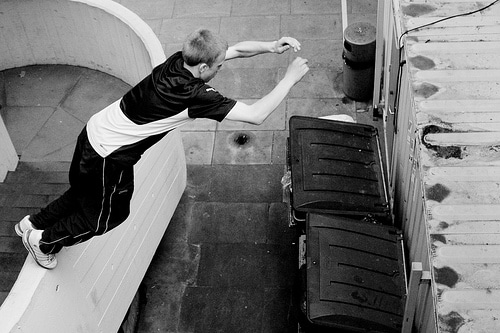
Jumping plays a big role in parkour. Use jumps to overcome height differences and to get across gaps and over obstacles.
Precision jumping
Precision jumps allow you to land on small areas, like the small surface on top of a wall or maybe a stepping stone in the middle of a body of water. Precision jumps require concentration, balance, and an awareness of your limitations.
Tic-Tac
Tic-tacs are sort of a combination of a wall-climb and a jump. This technique allows you to get to places that are higher than you could with a jump. You’ve probably seen tic-tacs in martial arts movies or on American Ninja Warrior. It’s where a person runs towards a wall at an angle, places a foot on the wall, and then pushes off from the wall with that foot to jump to a higher level. Tic-tacs are typically used in combination with another movement.
Drop
A drop is an active jump from a higher to lower level. When you’re first starting out with parkour, avoid dropping from anything higher than head-level. You need to master landing (see below) and you need to condition your body to the stress that comes from dropping from heights.
Landing
Knowing how to land safely and efficiently after jumping or dropping is an essential skill for parkour and freerunning. Landing correctly is what allows you to immediately get up and keep moving to the next obstacle, and, more importantly, not have to make a trip to the emergency room.
How you decide to land will depend on a few factors, namely: 1) the height you’re landing from, 2) the distance of your jump, 3) your landing surface, and 4) your preceding move.
Two-foot landing
Two-foot landings are more effective than one-foot landings at reducing the amount of stress your body experiences during landing. So when you can, try to land on two feet. When you land, you want your first contact with the ground to be with the balls of the feet, shoulder-width apart, knees over the tips of your toes.
Your goal is to land as “softly” as possible. To achieve that soft landing, bend your knees as you land — just make sure they don’t bend further than 90 degrees. If you’re jumping or dropping from a particularly high level or if you’re landing with a lot of forward momentum, let your torso sink towards your legs, and place your hands on the ground so your arms can help absorb some of the impact. Having your hands on the ground also puts you in a position to spring up and run to the next obstacle. This type of landing takes practice, so train from lower drops before moving to anything higher.
Rolling
Rolling is a vital landing skill to have if you want to avoid injuries. Rolling after landing spreads out the force of impact across more parts of your body, which reduces your chance of injury. You’ll typically want to drop to a roll after landing if you’re dropping from great heights or jumping horizontally with great forward speed. When performed correctly, a roll will allow you to land and pop right back up with nary a scratch on you.
You want to roll on your shoulder, diagonally across your back, so you’re rolling from one shoulder to the opposite hip. Tuck your head under your armpit as you go into the roll. Concentrate on rounding your body and making yourself into a ball. Keep yourself tucked as your weight carries you through the roll and keep your knees bent and your weight low as you rise to your feet.
Vaulting
As you’re running, you’re going to encounter obstacles that are too high to jump over. That’s where vaulting comes in. Vaulting is when you place your hands on an object to help you clear it. There are different kinds of vaults you can use depending on the obstacle you’re trying to clear and your personal preference. Brian Orosco from Tempest Freerunning Academy showed us five common vaults used in parkour and freerunning. You can see them in the video above. I’ve added links to various parkour sites that have step-by-step photo instructions of the vaults as well.
- Step (safety) vault. Step vault is the easiest vault and lays the foundation for the rest. It’s typically done when approaching an obstacle slowly.
- Speed vault. As the name suggests, the speed vault is performed when running at full speed.
- Lazy Vault. This is a good vault to use when you approach an obstacle at an angle. You’ve probably done this type of vault without even knowing it when you played as a kid. Whenever your body goes sideways over the obstacle without your feet touching it and you have just one hand planted on the obstacle, you’re doing a speed vault.
- Kong Vault. Kong vaults will make you look like you’re jumping over police cars like Caesar in Rise of the Planet of the Apes. This is an advanced vaulting technique. Don’t try this until you’ve had some experience parkouring.
- Dash Vault. The dash vault is sort of like the Kong vault, except you leap feet first instead of head first.
Climbing
Stairs are for chumps. Sometimes it’s just more efficient to use a direct route to get to a higher level. That’s where climbing comes in. Take it slow with climbing when you first start with parkour. You’re not going to have any safety harnesses, so a fall from a particularly high level can get you in the hospital or six feet under. General rule when climbing in parkour is “don’t climb higher than you can jump down.” Besides basic “ladder” style climbing, there are some other climbing techniques to be aware of.
Wall run

Source: Steven Erdmanczyk
Wall runs allow you to climb up a really high wall, really fast. The wall run is a deceptively complex movement. It’s a prominent obstacle on American Ninja Warrior, but it’s the one that many competitors have trouble with. To successfully execute a wall run you have to run, jump, climb, and hang in one fluid motion – not as easy as it looks.
Cat leap
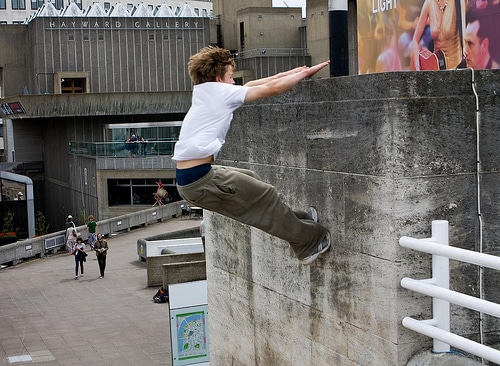
Source: JB London
The cat leap is a combination of a jump and a climb. You’ll use the cat leap when you have to span a gap, but the landing point is too high for you to land on your feet, so you have to hang from your hands when you get to the other side. Once you’re dangling from the edge of the building or wall, pull yourself to safety by bringing your knees into your chest and pressing your toes into the side of the building. Push your legs up by your toes and pull your body up by your hands at the same time. Really push with those legs — they’ll have much more strength and power than your arms. When your shoulders clear the top of the ledge, move your hands so that your palms are flat against the surface of the ledge, straighten out your arms, and push your body up. Lean forward so that your center of gravity is on the safety side, so you won’t fall if you lose your balance.
Swinging
Swinging from a bar or tree is used frequently in parkour. You’ll often see traceurs use swings to pass through an obstacle when there’s a gap between a rail and the ground.
Besides the basic underbar swing, you can get a bit fancier with the spiral underbar swing. Basically, you grip the bar in a way that causes you to spin as you swing under the bar. Pretty cool.
Parkour Resources
- Learn More Parkour They have a great YouTube channel. Some of the better “how-to parkour” videos out there.
- Ultimate Parkour & Freerunning Book (Very useful book. Step-by-step photo instructions with all the moves. Has a great section on the history of parkour.)
- American Parkour
Many thanks to Brian Orosco for taking the time to talk to us and show us some vaults. Make sure to check out his stunt reel. It’s pretty sick. If you’re ever in the L.A. area, I highly recommend stopping by the Tempest Freerunning Academy.
Further Reading
- Podcast: How to Live Like an Ancient Greek Hero
- How to Jump From Rooftop to Rooftop
- A Primer on MovNat


